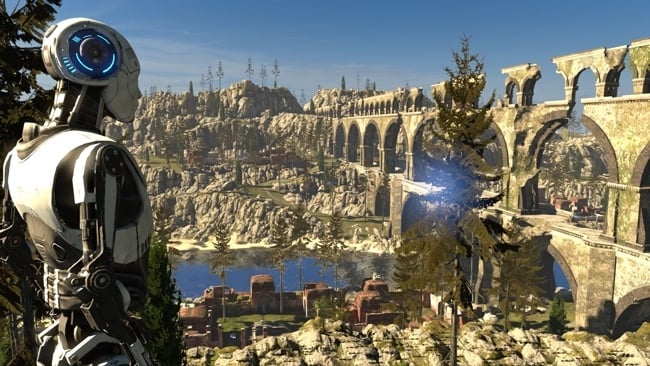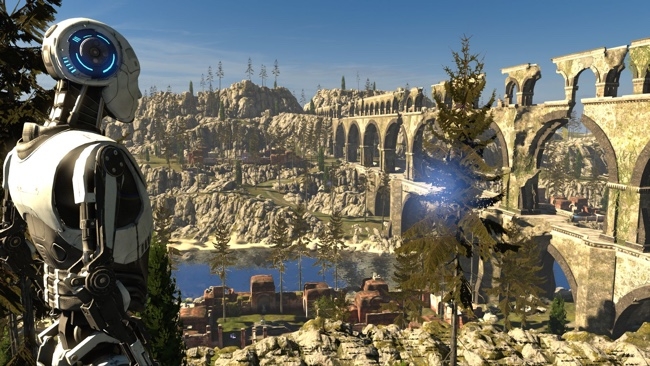
 The Talos Principle: big visuals on small(ish) budgets
The Talos Principle: big visuals on small(ish) budgets
The success of indie games such as The Talos Principle indicates that producing content for VR doesn’t have to be left to the major corporations with enormous budgets.
I’s just three years since Palmer Luckey effectively kickstarted the new Virtual Reality revolution with a Kickstarter campaign to fund development of his Oculus headset technology. Little wonder creatives in the arts and entertainment industries are only just beginning to grasp the whys, wherefores and hows of the medium.
It’s also small wonder that so much emphasis has thus far been placed on the possibilities VR provides for gaming. The world-building techniques used for first and even third-person video games are just as viable for immersing the player via a VR headset as through a TV or monitor, with little or no need to change the approach to modelling, shading, lighting, animation and rendering. Only the gameplay mechanics require a rethink, both to deal with the different way players navigate through those 3D spaces and also capitalise on the increased sense of immersion and possible emotional connection to the events that unfold.
But what of the new brave new interactive worlds that VR evangelists have promised us? Much of the focus has been developing interactive/animation hybrids — such as Henry from Oculus — that blend the visual detail and wonder of CG animated shorts from the likes of Pixar or Dreamworks with a new, responsive and multi-layered kind of storytelling. This too makes sense. While creating such graphically detailed content for real-time rendering is labour-intensive, these projects are relatable and more likely to be enjoy mainstream appeal and prove financially viable.
Beyond that, things are admittedly a little less clearly mapped out. When it comes to developing VR experiences that really utilise the format to educate and inspire, some argue that the manpower and costs involved with building the art assets and datasets that allow for every possible interaction the user might wish to make within a virtual environment are simply too great. If VR projects are as expensive (not to mention time-consuming) to develop as computer games then widespread VR use in academia becomes all but impossible.
There is a problem with this argument though. For one thing, while the comparison between VR experiences and computer games is a good one, there’s more to the latter than multi-million dollar blockbusters. Granted, development of Grand Theft Auto 5 involved several years, hundreds of artists and programmers, and a rumoured budget of £170 million, but that’s an extreme case. Not only is it the most expensive game ever developed, it also models an entire working city and living countryside some 30 square miles in size, wherein some hundred or so hours of interactive storytelling awaits.
Instead, we should be looking to ever-growing indie game market, where titles such as The Stanley Parable and The Talos Principle demonstrate that more intimate, yet immersive and visually rich 3D content can be developed by small teams with modest resources. The same low-cost tools used by indie developers — such as Blender, Modo Steam Edition, Maya LT, Unity, Unreal Engine — can help make educational VR content cost-effective, while a new generation of asset modification and creation tools such as Mixamo’s Fuse promise to radically democratise and accelerate asset creation.
Exciting VR-specific tools are also starting to emerge. OTOY has debuted a system for the lightfield capture of still environments, for example. 8i is launching a service to capture green-screened actor performances and recreate them as a 3D animated models. Then there’s Uncorporeal, whose technology captures both real-world environment and actor with sub-millimetre accuracy.
In addition to solving at a stroke the thorny issue of live-action video capture for VR, these tools have the potential to massively optimise and improve virtual world building. Why slave to create a nuanced virtual environment from scratch when you can grab some or all of it from the real-world? And why bother modelling, rigging and animating a cast of entirely artificial characters when you can quickly place real people giving complex, engaging performances into your virtual narrative?
VR has a way to go get, but as headset technology becomes ever more refined and affordable, there’s every indication that so too will content required to power it.
Tags: VR & AR


Comments